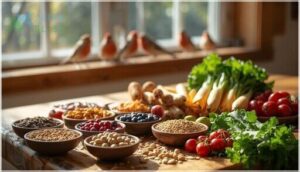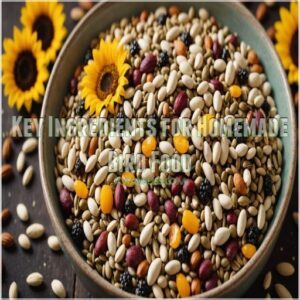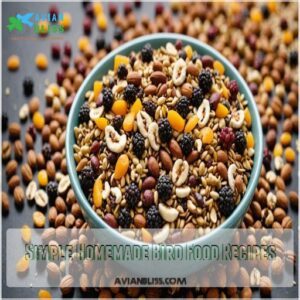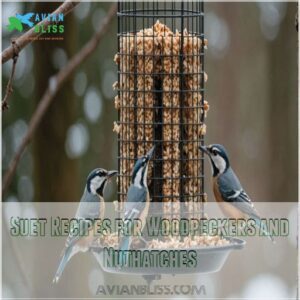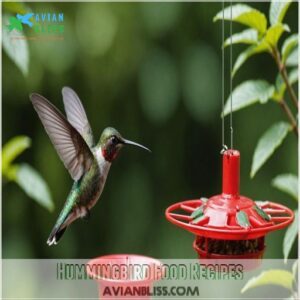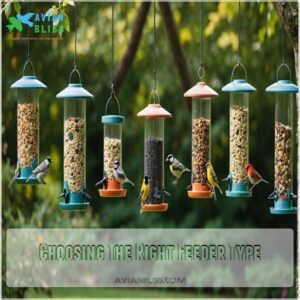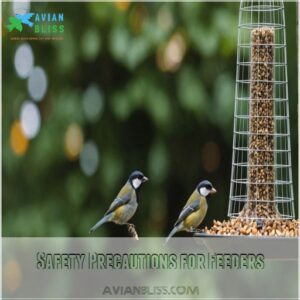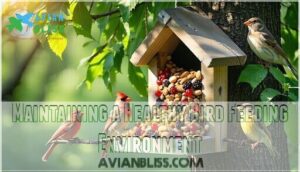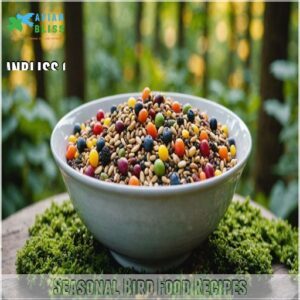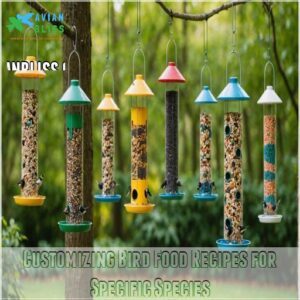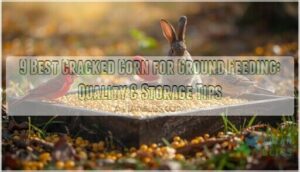This site is supported by our readers. We may earn a commission, at no cost to you, if you purchase through links.
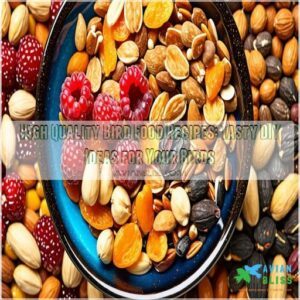
Mix seeds, fruits, and nuts for a nutritious feast.
Try a veggie rice medley or nutty energy balls – your birds will be doing backflips!
For woodpeckers, create a peanut butter suet that’ll have them drumming with joy.
Hummingbirds? Craft a simple sugar nectar or get fancy with fruit-infused versions.
You’re not just feeding birds; you’re creating a gourmet experience.
Plus, you’ll know exactly what’s in their food – no mystery ingredients here!
Stick around to discover how these recipes can transform your backyard into a bird paradise.
Table Of Contents
- Key Takeaways
- Benefits of Homemade Bird Food
- Key Ingredients for Homemade Bird Food
- Simple Homemade Bird Food Recipes
- Suet Recipes for Woodpeckers and Nuthatches
- Hummingbird Food Recipes
- Parrot Food Recipes
- Bird Feeder Selection and Placement
- Maintaining a Healthy Bird Feeding Environment
- Seasonal Bird Food Recipes
- Customizing Bird Food Recipes for Specific Species
- Frequently Asked Questions (FAQs)
- What is the best homemade bird feed?
- What is the healthiest thing to feed birds?
- How to make good bird food?
- What is the best bird food mix?
- How long can homemade bird food be stored?
- Are there any ingredients to avoid in bird recipes?
- Can I feed birds human food leftovers?
- How often should I change the bird food?
- Is it safe to add vitamins to homemade bird food?
- Conclusion
Key Takeaways
- You can create nutritious bird food at home using simple ingredients like seeds, fruits, and nuts, including adding cheese in moderation as a treat, especially hard cheese options, giving you control over what your feathered friends eat.
- Tailoring recipes for specific species, such as suet cakes for woodpeckers or nectar for hummingbirds, can attract a diverse array of birds to your yard.
- Seasonal adjustments to your bird food recipes ensure you’re providing the right nutrition throughout the year, from high-energy winter mixes to lighter summer blends.
- Regular cleaning of feeders and proper food storage are crucial for maintaining a healthy feeding environment and preventing the spread of diseases among birds.
Benefits of Homemade Bird Food
Making your own bird food lets you control the ingredients, ensuring your feathered friends get the best nutrition without any unhealthy additives.
Plus, mixing up different treats is like serving a birdie buffet, providing variety that keeps them happy and coming back for more!
Control Over Ingredients
Whipping up homemade bird food puts you in the driver’s seat with ingredient control.
You decide what goes into your bird’s diet and avoid any unwanted extras.
Plus, you can guarantee every bite packs a punch of nutrition.
- Customize blends to meet specific dietary needs.
- Source quality ingredients for better nutritional value.
- Create recipe variations to keep your feathered friends excited.
Tailored Nutrition
Knowing exactly what goes into your bird’s food is empowering!
You control the ingredients, avoiding unwanted fillers or additives found in store-bought mixes.
This lets you perfectly tailor your bird’s nutrition, addressing specific needs.
Homemade blends help prevent nutritional deficiencies and potential food allergies.
It’s a win-win for you and your feathered friend!
Plus, you can easily adjust recipes based on your bird’s species and health concerns.
Isn’t that awesome?
Variety and Enrichment
Ever notice how your feathered friend perks up with new treats?
That’s the magic of diet variety, as a balanced parrot diet including seeds, fruits, and essential nutritional elements helps prevent boredom and promotes healthy eating habits.
By rotating bird food mixtures and using natural ingredients, you boost their mental stimulation.
Toss in some nutty energy balls or craft egg and vegetable mash for that extra spark.
Plus, foraging toys can transform mealtime into a fun challenge.
Keep them engaged with inventive bird feeder recipes and bird treats!
Key Ingredients for Homemade Bird Food
Creating high-quality bird food starts with picking the right ingredients, like seeds, grains, and crunchy nuts, that can turn your backyard into a colorful bird haven.
By including fresh fruits and rich protein sources, you guarantee your feathered friends get a tasty, healthy meal that’s way better than any takeout!
Seeds and Grains
Imagine your bird savoring a tasty mix of seeds and grains.
These powerful ingredients are like a buffet for your feathered friend,
offering diverse seed types and whole grains that suit different bird preferences.
Crafting personalized seed mixes guarantees freshness and proper seed storage.
Mix up some seed and grain recipes today—your bird’s going to love this feast!
Fresh Fruits and Vegetables
Fresh fruits and vegetables are a vibrant addition to homemade bird food, offering a rainbow of nutrients.
Embrace seasonal options like crisp apples or juicy berries, ensuring a safe bird diet by washing them thoroughly.
For variety, chop veggies into bird-friendly sizes.
Remember, what Polly loves mightn’t tickle Tweety, so zero in on your bird’s unique preferences for avian nutrition.
Nuts and Legumes
Balancing your bird’s diet with nuts and legumes offers loads of protein, essential for a strong, active pet.
While considering legume benefits, don’t overlook nut allergies and shell safety.
Store nuts properly to keep them fresh for homemade bird food recipes.
Birds at your feeders will appreciate the tasty variety, and your parrot diet will be both diverse and intriguing!
Cooked Whole Grains
For your feathered friends, cooked whole grains can be a hit! They’re nutritious and incredibly versatile. From quinoa to brown rice, these grains cater to various bird preferences and digestion.
Here’s how you can use them:
- Grain types: Quinoa, oats, barley, brown rice
- Cooking methods: Boil or steam
- Recipe ideas: Veggie rice medley, bird chop mix
- Benefits: Easy to digest and nourishing
Protein Sources
Now that we’ve covered grains, let’s talk protein!
Protein is key for healthy birds, and luckily, there are tons of options.
Hard-boiled eggs are a winner, providing a protein boost.
Mealworms are another favorite; they’re packed with protein and birds gobble them up.
You can also add cooked lentils or even small amounts of shredded cooked chicken (no bones!).
Remember to always offer variety for a balanced diet, keeping your feathered friends happy and healthy.
Protein for hummingbirds and parrots needs careful consideration, though – research their specific needs!
Simple Homemade Bird Food Recipes
You don’t need to visit a gourmet restaurant to give your feathered friends a nutritious treat; try your hand at these simple homemade bird food recipes.
Whether it’s a colorful seed and fruit mix or energy-packed nutty balls, these DIY options offer the perfect blend of flavor and nourishment to keep your backyard birds chirping with joy!
Seed and Fruit Mix
Think your winged pals might be getting bored with their usual snacks?
A seed and fruit mix could be just the ticket!
Toss in diverse seed mix variations and juicy fruits your birds fancy.
Tailor this recipe to seasonal variations and bird species preferences.
You can boost the mix with healthy protein sources for birds, ensuring they’re feeling chirpy and energetic!
Veggie Rice Medley
Mixing up a Veggie Rice Medley for your backyard birds adds zest to their diet, much like your Seed and Fruit Mix.
Toss in seasonal veggies and cooked rice for this budget-friendly dish.
Embrace bird-friendly plants to keep it fresh.
Remember, cleaning feeders guarantees safety.
Let your feathered friends enjoy a nutritious, delightful feast while you watch from a cozy spot.
Nutty Energy Balls
Give your feathered friends a treat with nutty energy balls.
Packed with seeds and nuts, these tasty tidbits provide essential nutrients, especially in cold weather.
Much like the nutrient-rich ingredients in top parrot food brands that blend nutrient-rich ingredients like quinoa and freeze-dried fruits.
Experiment with recipe variations to keep things interesting, and don’t worry if you run low on ingredients—substitute freely.
Store these snacks in a cool, dry place, and watch those songbirds flock to your feeder!
Egg and Vegetable Mash
Crack open a new hobby with egg and vegetable mash—a perfect power meal for your feathery companions!
By combining scrambled eggs with veggies, you tweak the recipe for variety and nutritional value.
This mash suits parrot preferences, and you can adjust serving sizes too.
While you’re at it, remember bird migration and bird watching tips to enrich your experience.
Suet Recipes for Woodpeckers and Nuthatches
If you’re looking to treat woodpeckers and nuthatches, try making suet at home with simple ingredients like peanut butter and seeds.
These DIY recipes attract these delightful birds but also help them get the energy boost they need, especially during colder months.
Classic Peanut Butter Suet
Creating a classic peanut butter suet is easier than you think!
This high-energy treat is a woodpecker and nuthatch favorite.
You’ll need:
- One cup of peanut butter (creamy or crunchy, your call!).
- Two cups of rendered suet (beef or vegetable).
- One cup of birdseed.
Mix everything together well, then press it into a DIY suet mold or simply shape it into balls.
Remember proper Suet feeder placement and Suet storage tips for best results!
Jack Dudley’s Woodpecker Pudding
After enjoying the classic peanut butter suet, let’s talk about Jack Dudley’s Woodpecker Pudding.
As woodpeckers and nuthatches are among the birds that love suet, this DIY suet blend combining nutty flavors is sure to be a hit with them, especially during cold weather when suet provides energy.
This DIY suet blend combines nutty flavors that feathered diners, especially woodpeckers, adore!
Tweak the recipe with sunflower seeds or dried fruits for variations that suit bird preferences and encourage winter feeding.
Imagine your backyard bustling with happy nuthatches exploring this tasty offering.
Who knew cooking for birds could bring such joy and companionship?
Suet Cakes With Seeds and Nuts
Ever wondered why suet cakes with seeds and nuts are a hit with woodpeckers?
They love the protein-packed punch these cakes deliver!
Start with suet cake recipes using lard or peanut butter as a base.
Add seeds, nuts, and a dash of cornmeal for variety.
Suet cake storage is a breeze—just freeze until you’re ready.
The benefits? Happy birds and fewer bugs around your yard.
Hummingbird Food Recipes
You’re about to become a hummingbird’s best friend with these easy and effective recipes!
By making your own nectar, you can guarantee it’s perfectly sweet and just what these little birds need to keep zooming around your garden all day.
Simple Sugar and Water Nectar
Imagine a hummingbird zipping up to enjoy a sip of your homemade nectar.
Don’t fret—it’s easy as pie! Mix one part sugar with four parts water to create the perfect nectar concentration.
Skip those sugar substitutes; they don’t jive with hummingbird health.
Refresh your feeder regularly, especially during peak feeding frequency, and you’ll have these charming visitors buzzing about in no time.
Cheers to joyful birdwatching!
Fruit-Infused Nectar
Mixing up a fruit-infused nectar for hummingbirds can be as delightful as choosing the perfect fruit combinations.
You can also buy pre-made hummingbird nectar online at stores like Everysimply Hummingbird Nectar.
With a little experimentation, you’ll find the ideal balance for nectar consistency that suits their picky palates.
Think homemade vs. store-bought – yours can be fresher and tastier!
Hummingbird preferences might change with the seasons, so tweak your recipe for seasonal variations.
Your feathered friends will thank you with a joyful display.
Hummingbird-Friendly Plant-Based Nectar
Whipping up a hummingbird-friendly plant-based nectar is like brewing magic for these tiny flyers.
You’ll want to mix 1 part organic sugar with 4 parts water—no honey or artificial sweeteners, please!
Keep it simple to mimic flower nectar.
Fill your nectar feeders with this DIY recipe, and you’ll witness delightful hummingbird behavior as they zip and zoom around, grateful for your garden’s sweet offerings.
Parrot Food Recipes
Want to make your parrot’s meals more exciting? We’ve got delicious and nutritious parrot food recipes that are easy to make, using ingredients you probably already have!
Sweet Potato Balls
Ever wondered how to spoil your parrot with nutritious treats?
Sweet Potato Balls are your answer.
Packed with sweet potato benefits, these homemade treats are nutrient-rich and freezable.
Easy to make, just mix mashed sweet potato with oats, raisins, and fruit.
Roll them into balls, freeze, and voilà!
Your feathery friend gets a delicious, healthy snack.
Veggies and Grains Chop Mix
Imagine this: your parrot waddles over, eyeing the colorful array of a freshly made Veggies and Grains Chop Mix.
This nutritious feast is a must-try.
Vary the veggies, whether fresh or frozen, to match your bird’s preferences.
Keep trying until they’re hooked.
Remember, adjusting recipes makes all the difference and brings out the best Chop Mix benefits.
Green Smoothie
Explore a tasty universe of flavors with your parrot’s very own green smoothie! It’s a splash of parrot nutrition packed with fresh ingredients.
Blend soaked pellets with bananas, mango, and leafy greens, and for an extra nutritional boost, consider incorporating a balanced mix of fruits and veggies, like those found in a complete avian diet.
Make adjustments to fit your bird’s taste, and discover these smoothie benefits:
- Kale
- Brussels sprouts
- Swiss chard
- Apple cranberry juice
- Filtered water
Pellet Paste
After your birds sip on a green smoothie, why not try some pellet paste for variety?
It’s perfect for helping birds adapt to a new diet.
You’ll make a thick homemade pellet paste by mixing crushed pellets with seeds and a dash of water.
The paste consistency encourages nibbling while offering pellet paste benefits.
Serve rolled into balls or as seed cakes.
Bird Feeder Selection and Placement
Picking the right bird feeder and placing it just so can turn your backyard into a busy avian café.
Whether you’re catering to finches or attracting woodpeckers, a bit of strategy helps guarantee your feathered friends can feast safely and you can enjoy the show.
Choosing The Right Feeder Type
Finding the perfect bird feeder is more than a simple task—it’s about matching design with the habits of your bird buddies, considering different bird feeder types that attract specific species.
When deciding on a feeder location, it’s important to think about the ideal spot, such as placing feeders 12 feet from bushes.
Keep these things in mind when choosing:
- Feeder size: Bigger ones hold more food.
- Bird species: Preferences differ; some birds like hanging feeders, others don’t.
- Feeder location: Secure spots matter.
- Feeder material: Durable materials last longer.
- Feeder design: Easy refills make life easier.
Placement Strategies for Optimal Viewing
Want the best bird’s-eye view of your feathered friends? Position your feeders strategically!
Consider bird feeder height; many birds prefer feeders at least 3-5 feet off the ground to avoid predators.
Think about feeder location—a spot near shrubs offers cover.
Window placement is key for close-up viewing, but be mindful of bird safety.
Different bird species have different preferences, so research what works best for your backyard design and the birds you want to attract.
Experiment and have fun!
Safety Precautions for Feeders
Feeder safety’s no joke—your backyard feathery friends depend on it!
Keep things clean to dodge diseases and guarantee predator prevention by choosing a feeder with a slick design.
Placement tips? Hang feeders high and away from crafty critters to ace rodent control.
For a safe bird banquet, your feeders should be sturdy and easy to maintain—you’re setting the bird buffet after all!
- Ensure sturdy construction
- Clean regularly
- Hang feeders high
- Choose predator-proof models
Maintaining a Healthy Bird Feeding Environment
Creating a healthy bird feeding environment is essential for your feathered friends’ well-being and happiness, as a diet rich in protein and nutrients such as insects for baby birds, so don’t forget to regularly clean your feeders and refresh water sources to keep the birds chirping.
Managing pests and predators might sound like running a wildlife reality show, it actually keeps your backyard lively and safe for all the right reasons!
Cleaning and Disinfecting Feeders
You’ve picked the perfect feeder spot, now keep it clean!
Use bleach solutions or whip up some DIY cleaners.
Aim for a cleaning frequency that’s regular but not a chore.
Different feeder types require unique care—safety tips help too!
Imagine you’re digging for treasure in dirty feeders—minus the gold.
Here’s a quick guide:
| Feeder Type | Cleaning Tip |
|---|---|
| Tube Feeder | Scrub monthly |
| Platform | Rinse weekly |
| Hummingbird | Refresh every 2 days |
Refreshing Bird Baths and Water Sources
Keeping your feathered friends’ watering holes fresh is like rolling out the red carpet for them.
Clean water‘s a real game-changer for birds, so let’s take a closer look at some great tips:
- Scrub-a-dub daily: Give that bird bath a quick once-over every day.
- H2O swap: Change the water frequently, especially on scorchers.
- Location, location, location: Place baths in shady spots, away from predators.
- Go natural: Use rain or filtered water to avoid chlorine and other chemicals.
Remember, a clean bath’s a happy bath!
Managing Pest Attractors and Predators
While fresh water attracts feathered friends, it can also lure unwanted guests.
Let’s tackle those pesky predators and pests!
Start by placing feeders away from hiding spots – think open areas where birds can spot danger.
Try natural repellents like cayenne pepper to deter squirrels, or install baffles to outsmart clever climbers.
Modify your yard with thorny bushes to discourage cats.
Remember, a clean feeding area is key to keeping rodents at bay.
With these tricks, you’ll create a safe haven for your winged pals!
Seasonal Bird Food Recipes
You’ll love how seasonal bird food recipes keep your feathered friends happy year-round.
By understanding that wild birds consume a diverse range of foods including seeds, insects, fruits, and small animals, as seen in bird facts about their diet, by tweaking ingredients based on what’s naturally available, you’re not just feeding birds – you’re giving them a taste of their wild diet right in your backyard.
Winter Bird Food Recipes
Winter’s chill calls for hearty bird fare!
Whip up a DIY suet recipe to keep your feathered friends fueled.
Mix equal parts peanut butter and cornmeal, then add sunflower seeds and dried fruit.
Press the mixture into a mold and freeze.
For best winter bird nutrition, place feeders near sheltered areas.
Remember, fat-rich recipes are important for birds’ energy needs.
Your backyard buddies will thank you with their cheerful presence all season long!
Spring and Summer Bird Food Recipes
As the weather warms up, it’s time to switch up your bird buffet!
Spring and summer call for lighter fare.
Whip up a delightful summer seed mix with sunflower hearts, millet, and dried fruit.
Try a spring fruit recipe by blending berries and chopped apples.
Don’t forget the hummingbirds – they’ll buzz with joy over homemade nectar.
Toss in some fresh greens for a nutritious boost.
By using lard-free bird seed balls made with peanut butter and other healthy ingredients, your feathered friends will have a nutritious and tasty treat that can be made at home by following a simple recipe like the one at How to Make Bird Seed Balls Without Lard. Your feathered friends will flock to these tasty homemade bird treats, turning your yard into the hottest spot in town!
Fall Bird Food Recipes
Fall’s crisp air signals it’s time to whip up some hearty bird treats.
For the best results, start with a high-quality bird seed mix, and consider a custom blend from bird seed suppliers online.
Your feathered friends will flock to these autumn-inspired recipes:
- Pumpkin seed mix: Blend roasted pumpkin seeds with sunflower seeds and dried cranberries
- Apple-cinnamon suet: Mix rendered suet with diced apples and a dash of cinnamon
- Nutty acorn squash: Stuff halved acorn squash with a mix of nuts and seeds
- Maple-glazed millet: Coat millet in a light maple syrup glaze, then bake until crispy
These recipes will keep your backyard bustling with happy birds all season long.
Customizing Bird Food Recipes for Specific Species
You can attract a variety of birds, including blackbirds, finches, and sparrows, by incorporating nutritious ingredients like types of oats safe for birds. You can turn your backyard into a bird paradise by whipping up custom recipes for different feathered friends.
From seed mixes that finches can’t resist to fruity treats that’ll have cardinals singing your praises, you’ll learn how to cater to the unique tastes of various bird species.
Recipes for Attracting Finches and Sparrows
Ready to become a finch and sparrow whisperer?
Let’s whip up some irresistible treats for these feathered friends.
You’ll have them flocking to your yard in no time with these budget-friendly recipes.
Check out this quick guide to their favorites:
| Seed Type | Finch Favorites | Sparrow Delights |
|---|---|---|
| Tiny Seeds | Nyjer, Thistle | Millet, Canary |
| Medium Seeds | Sunflower Hearts | Cracked Corn |
| Extras | Fruit pieces | Peanut hearts |
Mix these seeds with some DIY feeder tips, and you’ve got a winning winter mix that’ll keep your backyard buzzing!
Recipes for Attracting Cardinals and Blue Jays
Want to be the go-to restaurant for cardinals and blue jays?
Whip up a custom seed blend they can’t resist!
Mix sunflower seeds, peanuts, and safflower seeds for a winter feast.
These colorful characters love a hearty meal, so don’t skimp on the good stuff.
Toss in some cracked corn for blue jays and add dried fruit for cardinals.
You’ll have a backyard diner that’s bustling with feathered foodies in no time!
Recipes for Attracting Hummingbirds and Orioles
With a dash of creativity, you can whip up irresistible treats for hummingbirds and orioles.
Mix up a batch of homemade nectar by dissolving one part sugar in four parts water.
For orioles, slice up some juicy oranges or set out grape jelly.
Experiment with different hummingbird nectar variations to keep things interesting.
- The thrill of seeing a hummingbird hover at your feeder
- The joy of an oriole’s vibrant orange plumage brightening your yard
- The satisfaction of providing a nurturing haven for these beautiful creatures
- The excitement of becoming the go-to spot for neighborhood birds
Frequently Asked Questions (FAQs)
What is the best homemade bird feed?
Feather your nest with a homemade treat!
Whip up a suet mix using peanut butter, cornmeal, and seeds.
It’s a hit with woodpeckers and chickadees.
For variety, try a fruit and nut blend or homemade hummingbird nectar.
What is the healthiest thing to feed birds?
You’ll hit the jackpot with natural, varied foods for your feathered friends.
Mix up a buffet of seeds, nuts, fruits, and insects.
It’s like serving a gourmet meal – they’ll chirp with delight and stay healthy!
How to make good bird food?
Mix up a birdie buffet!
Blend seeds, nuts, and dried fruits for a tasty treat.
Whip up homemade suet with peanut butter and cornmeal.
Don’t forget fresh fruits and veggies too.
Your feathered friends will be chirping with delight!
What is the best bird food mix?
The best bird food mix caters to local species.
Black oil sunflower seeds attract a variety of birds.
Add nuts, millet, and suet for diversity.
Experiment with different combinations to find what your feathered friends prefer.
It’s like crafting a buffet for birds!
How long can homemade bird food be stored?
While you might think homemade bird food lasts forever, it’s best to use it within 1-2 weeks.
Store dry mixes in airtight containers at room temperature.
Refrigerate suet and moist foods, using them within 3-5 days to keep your feathered friends healthy.
Are there any ingredients to avoid in bird recipes?
Definitely steer clear of chocolate, avocado, and onions in your bird recipes.
They’re toxic to our feathered friends.
Also, nix the salt and sugar – they’re not great for birds.
Stick to natural, bird-safe ingredients for happy, healthy chirpers.
Can I feed birds human food leftovers?
Did you know that 70% of wild birds’ diets consist of natural foods?
While it’s tempting to share your leftovers, it’s best to stick to bird-specific foods.
Human food can lack essential nutrients and may even harm our feathered friends.
How often should I change the bird food?
Change your bird food every 1-2 days to keep it fresh.
Damp or moldy food can make birds sick.
Clean feeders weekly with a mild bleach solution.
You’ll be the neighborhood’s favorite bird restaurant in no time!
Is it safe to add vitamins to homemade bird food?
Well, isn’t it ironic? You’re trying to be a bird’s personal nutritionist!
While it’s tempting, adding vitamins to homemade bird food can be risky.
You’re better off sticking to natural, balanced ingredients that mimic their wild diet.
Keep it simple, bird-brain!
Conclusion
Whipping up high quality bird food recipes isn’t just for the birds – it’s a treat for you too!
You’re not just feeding feathered friends; by offering treats like air-popped popcorn for birds, you’re creating a vibrant ecosystem in your backyard.
Experiment with different ingredients, watch which recipes your birds love, and enjoy the show.
Remember, consistency is key.
Keep those feeders clean and full, and you’ll have a flock of regulars in no time.
So grab your apron and get mixing – your avian pals are waiting for their next gourmet meal!

